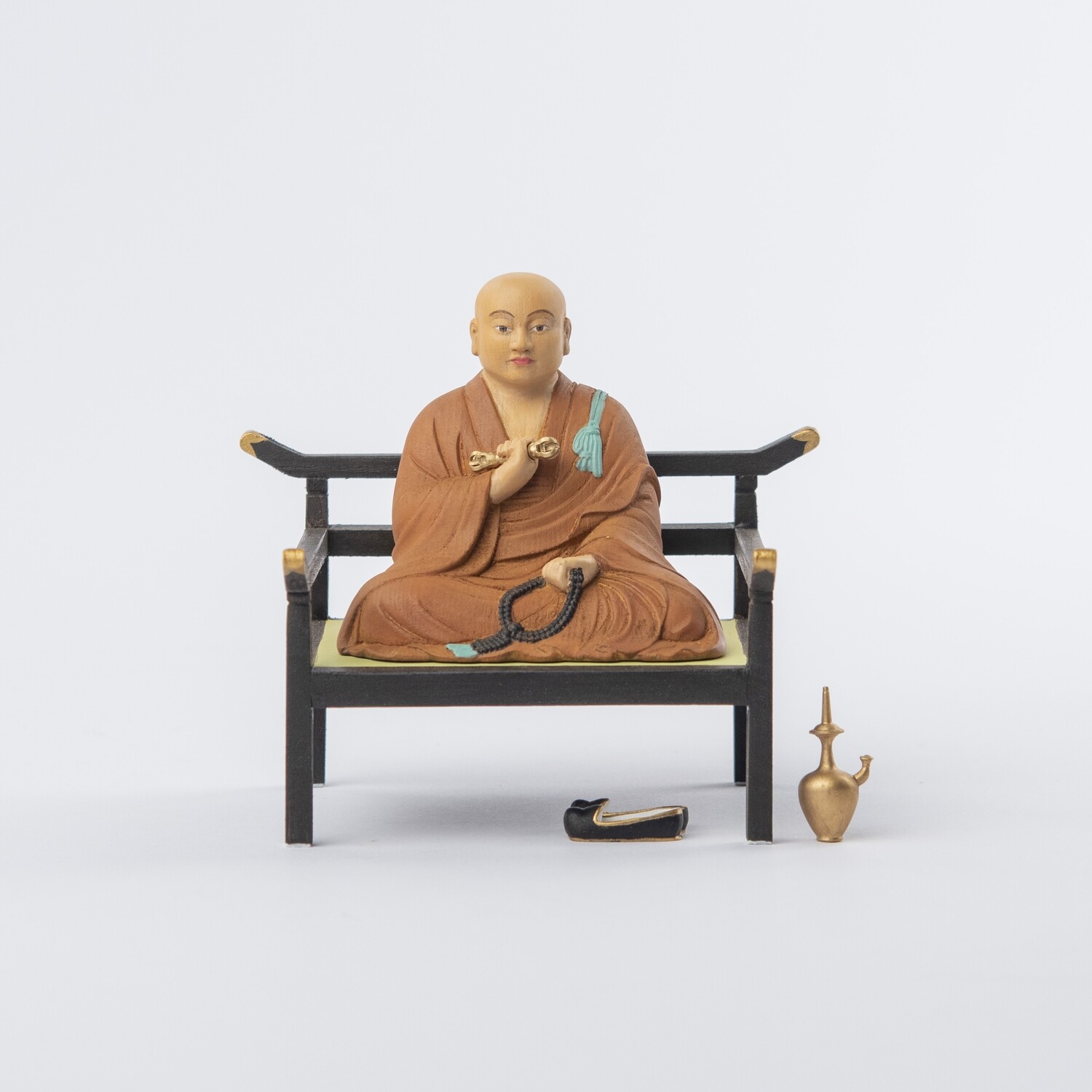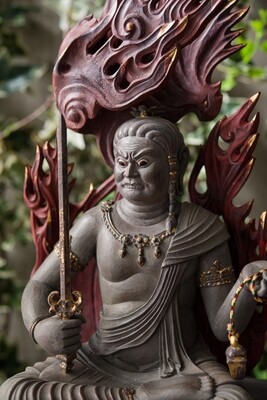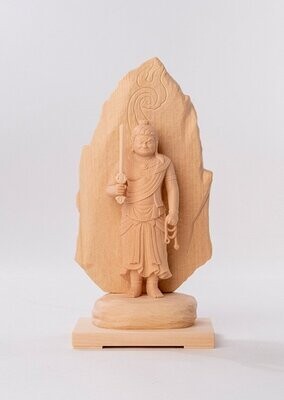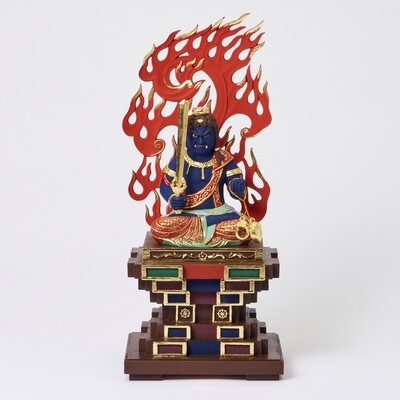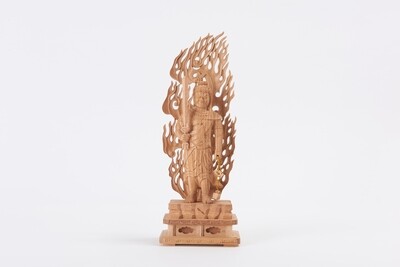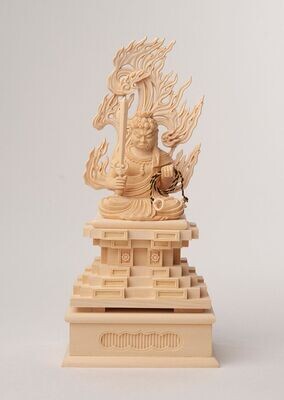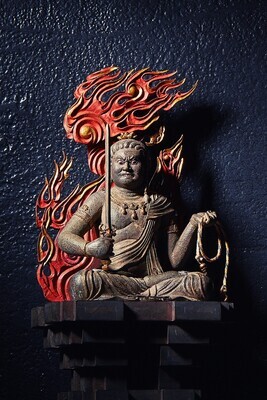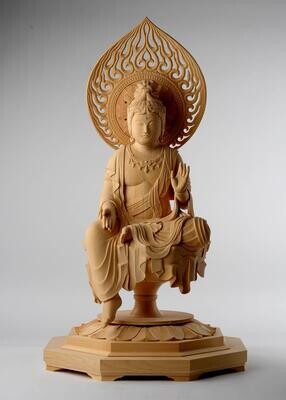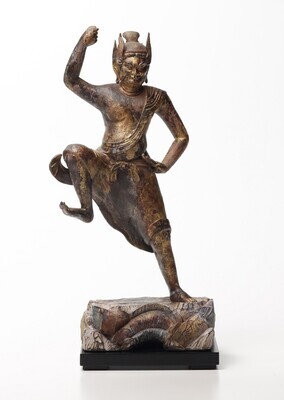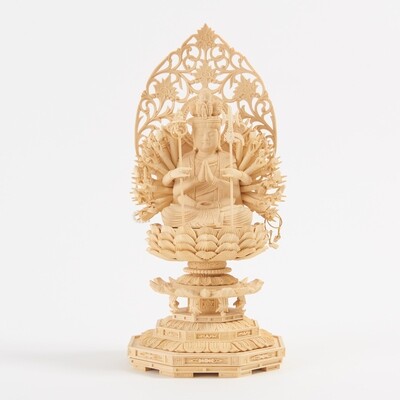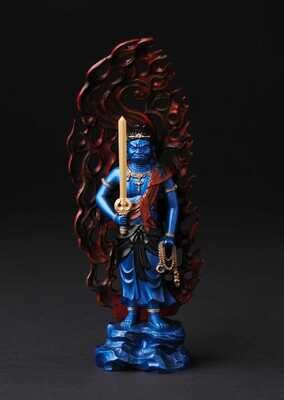Kobo Daisi(木造 弘法大師坐像 身丈2寸)
The year 2023 in the Reiwa era marks the 1250th anniversary of the birth of the founder of Japanese Shingon Esoteric Buddhism, Kobo Daishi (also known as Kukai).
In honor of this historic occasion, efforts were made to develop a new form of the Kobo Daishi statue. Various images and texts from tradition were researched and studied, and the input of Shingon sect monks was sought. After approximately three years of work, a new form was created that embodies the unwavering determination of Kobo Daishi, who received the initiation as the eighth patriarch of Shingon Esoteric Buddhism from his master, Eko Ajari, in Tang China, and dedicated his life to spreading its teachings in Japan.
The prototype of the statue, carved by the Buddhist sculptor Youoku Fujita, portrays Kobo Daishi with resolute eyes filled with a strong sense of purpose. The skilled colorist Chihiro Takamura brought the statue to life with vibrant coloring, achieving a remarkable level of realism.
To produce the final product based on the completed prototype, high-precision 3D scanning was used to capture the data. Skilled woodworkers then carved the statue with precision, and it was hand-painted in the "Isumu" workshop, creating a sublime representation of Kobo Daishi. This palm-sized masterpiece can be used as a dignified art piece or as an addition to your home altar.
Despite its small size (approximately 10 cm), the statue faithfully reproduces the features and balance of the original prototype without compromise. The coloring, from the clothing to the expression, faithfully reflects the colorist's artistic vision.
The statue includes symbols representing esoteric Buddhism, such as the five Buddhas (Dainichi Nyorai, Acala, Amoghasiddhi, Amitabha, and Fudo Myoo) and their wisdom (Dharmakaya, Jnana Dharmakaya, Sambhogakaya, Dharmadhatu Wisdom, and All-Accomplishing Wisdom). The water flask symbolizes the legitimate successor in esoteric Buddhism, signifying the transmission of esoteric teachings from master to disciple without any leakage, known as "sha-byo-so-sho" in Japanese.
In his youth, Kobo Daishi engaged in intensive training at Miku-do, a cave on Cape Muroto in Tosa Province (present-day Kochi Prefecture). During this time, he had a profound spiritual experience that connected him with the beauty of the sky and sea, leading him to change his name from "Shingyo" to "Kukai" and dedicate his life to Buddhism.
One of Kukai's remarkable achievements was receiving initiation as a master of Shingon Esoteric Buddhism in just three months, an unusually short time. Frustrated by his inability to find a satisfactory understanding of the depths of Buddhism through extensive scripture study, Kukai fervently prayed for true wisdom before the Buddha. In response, he received a divine revelation that led him to the Great Sun Sutra, which he found under the Eastern Pagoda of Kume-dera in Yamato Province (present-day Nara Prefecture). This encounter provided answers to his questions, but he realized that to truly connect with the divine and invoke its blessings, he needed to study under a qualified master. This revelation became the catalyst for his decision to travel to Tang China as part of a diplomatic mission.
In 804, Kukai's dream came true when he set sail for Tang China alongside Saicho, the founder of Japanese Tendai Buddhism. They faced numerous challenges during their journey, including a month-long storm at sea. Upon their arrival in a remote area far from their intended destination of Suzhou, they faced suspicion. However, thanks to Kukai's eloquent letter and his mastery of calligraphy, they were finally recognized as envoys. In May of the following year, Kukai met Eko Ajari, the head priest of Shoryu-ji in Chang'an, and Eko immediately recognized Kukai as his disciple. In the subsequent months, Kukai received the initiations of the Garbhadhatu Mandala, Vajradhatu Mandala, and the transmission as a master of esoteric Buddhism. This earned him the name "Henjo Kongo," symbolizing his connection to the Great Sun Buddha. After imparting all the teachings, Eko Ajari expressed his wish for Kukai to return to Japan as soon as possible and use these teachings to bring happiness to people. Eko Ajari passed away on December 15 of the same year.
Kobo Daishi (Kukai)
June 15, 774 – March 21, 835
The founder of Japan's Shingon sect of esoteric Buddhism, posthumously known as Kobo Daishi. He is also counted among the "Three Brushes" alongside Emperor Saga and Tachibana no Hayanari for his calligraphy skills.
He was born in Sanuki Province (modern-day Zentsuji City, Kagawa Prefecture) with the secular name Saeki no Mao. In 804, he embarked on a journey to Tang China along with the founder of Japan's Tendai sect, Saicho. In Chang'an, Kukai studied the esoteric secrets of Buddhism under the guidance of Eko Ajari at Shoryu-ji Temple and received the name Henjo Kongo through initiation. He returned to Japan in 806. In 815, he established the Shikoku Pilgrimage of 88 Temples. In 816, he was granted the authorization to establish Koyasan as a place for meditation and training, and it became the central dojo (training hall) for Shingon esoteric Buddhism. In 823, he received permission from the imperial court to establish To-ji Temple as the central dojo for esoteric Buddhism. In 835, he entered into eternal meditation (nirvana). Today, in the Okunoin Cemetery on Mount Koya, where Kukai entered into meditation, the practice of "shojingu" continues, with daily offerings of food to Kobo Daishi. "Kobo Daishi" is a posthumous title bestowed upon him by Emperor Daigo after his entry into meditation.
- Size: 95(H)×105(W)×80(D)mm, 46g
- Material: Hinoki / 檜
- You can choose the option to consecrate this statue (give an eye-opening ceremony) before it is shipped from Japan. If you choose this option, we will bring the statue to a Japanese temple, and pay them the necessary fees so that your statue is properly consecrated. The temple will issue a certificate of proof with your name on it, which will also be shipped together with your statue
- Shipped globally from Japan by using DHL. DHL is the world-class shipping services provider who makes international delivery a fast, smooth, and hassle-free experience. Delivery time can be faster than when shopping at an e-commerce website in your country, and of course your package will be covered by insurance. You can check the shipping cost for your entire order before you make a purchase
